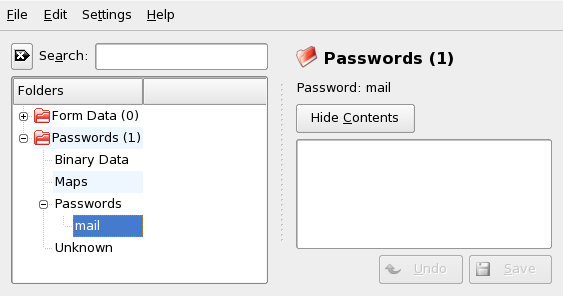1.13 Managing Passwords with KWallet Manager
Remembering all the passwords for protected resources to which you need to log in can be problematic. KWallet remembers them for you. It collects all passwords and stores them in an encrypted file. With a single master password, open your wallet to view, search, delete, or create entries. Normally you do not need to insert an entry manually. KDE recognizes if a resource requires authentication and KWallet starts automatically.
IMPORTANT: Protect Your KWallet Password
If you forget your KWallet password, it cannot be recovered. Furthermore, anyone who knows your password can obtain all information contained in the wallet.
1.13.1 Starting KWallet
When KWallet starts for the first time (for example, when you access a Web site where you must enter a password to log in), a dialog appears with the welcome screen. Choose between (recommended) and . If you choose , in the next screen you can choose whether to store personal information. Some KDE applications, such as Konqueror or KMail, can use the wallet system to store Web form data and cookies. Select to activate KWallet and leave with .
If you choose , you have an additional security level screen. The default settings are generally acceptable for most users, but others may wish to change them. closes wallets after a period of inactivity. To separate network passwords and local passwords, activate . Close with .
You can alter the settings at any time by right-clicking the KWallet icon in the panel and selecting . A dialog box opens where you can select several options. By default, all passwords are stored in one wallet, , but you can also add new wallets. Once configured, KWallet appears in the panel.
1.13.2 The KWallet Manager
To store data in your wallet or view its contents, click the KWallet icon in the panel. A dialog box opens, showing the wallets that are accessible on your system. Click the wallet to open. A window prompts for your password.
After a successful login, the KWallet Manager window opens. It is divided into four different parts: the top left part displays a summary, the top right part displays subfolders, the lower left part shows a list with folder entries, and the lower right part shows the contents of a selected entry.
In the KWallet Manager, you can change your master password for KWallet at any time with .
Figure 1-17 The KWallet Manager Window

You can add or delete folders. Selecting a folder updates the folder entry list and the summary display. Selecting a folder entry updates the entry contents pane and allows you to edit that entry. Entries can also be created or deleted using the context menu for the folder contents.
1.13.3 Copying Your Wallet to Another Computer
For the most part, KWallet resides silently in the panel and is automatically activated if needed. However, you can copy your wallet files to another computer (for example, your laptop). To simplify this task, wallets can be dragged from the manager window to a file browser window. This let you easily package a new wallet for transfer to another environment. For example, a new wallet could be created and copied onto a removable flash memory device. Important passwords could be transferred there, so you have them available in other locations.